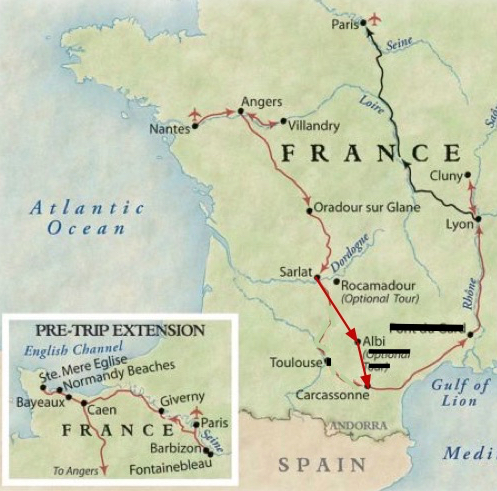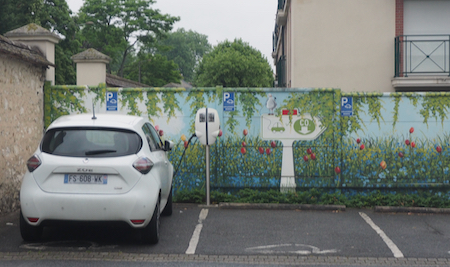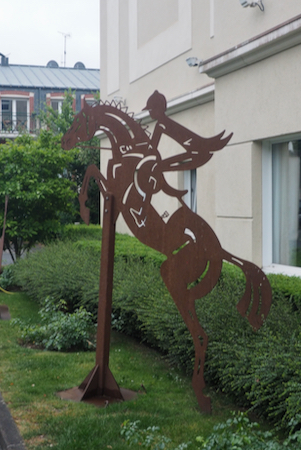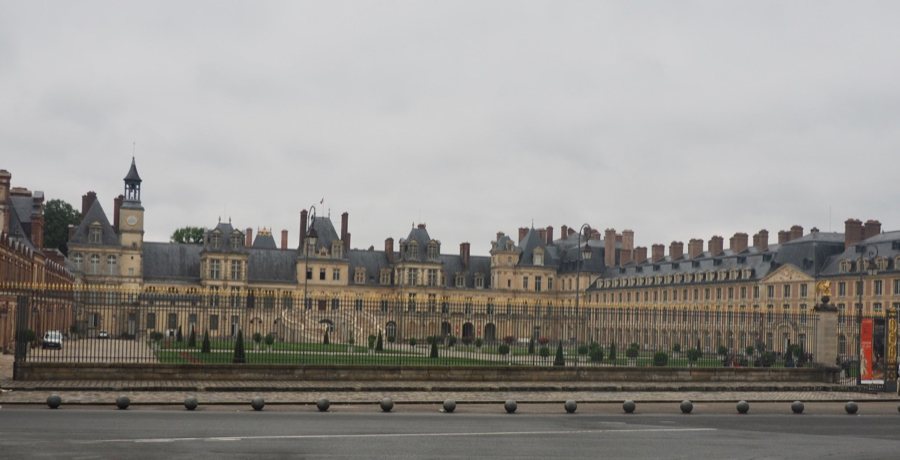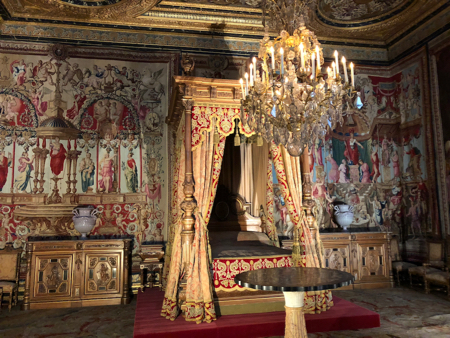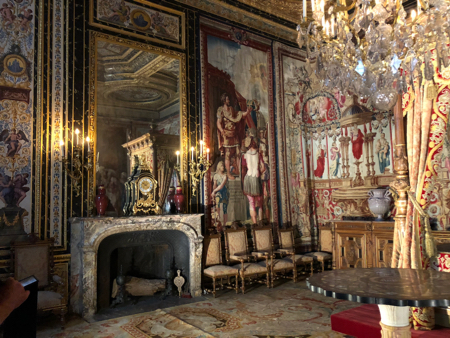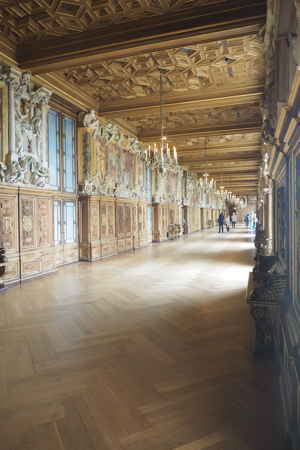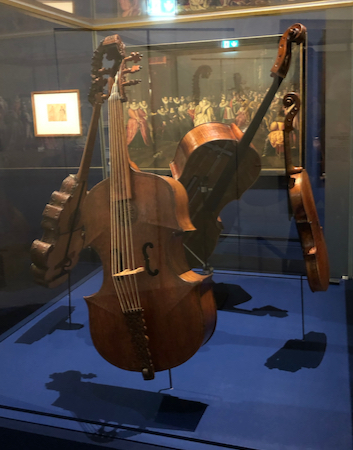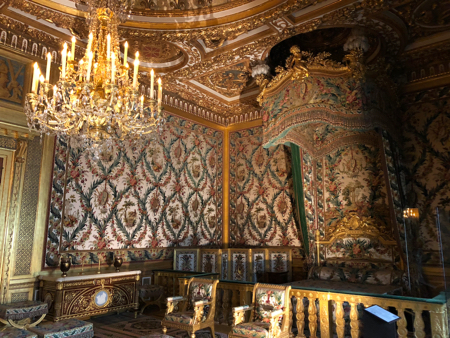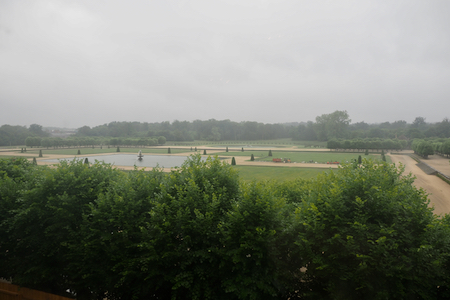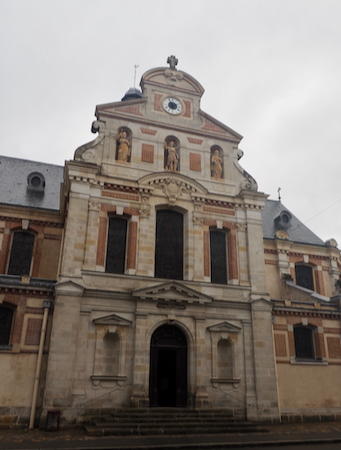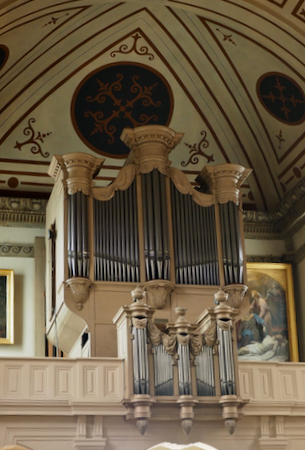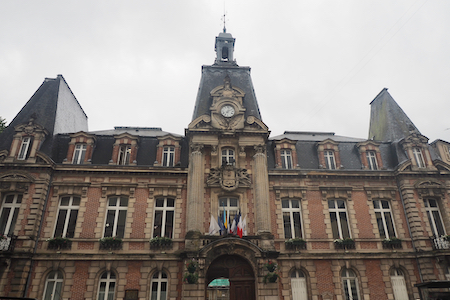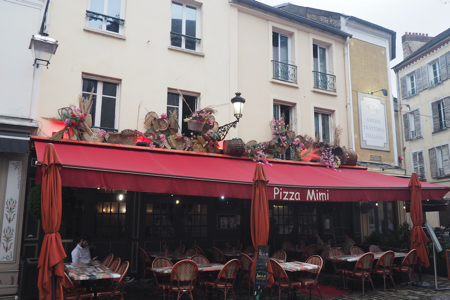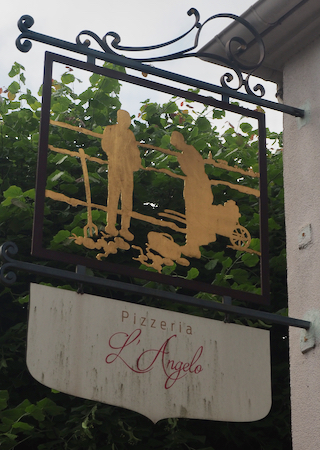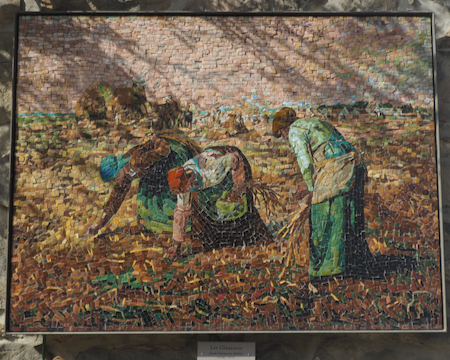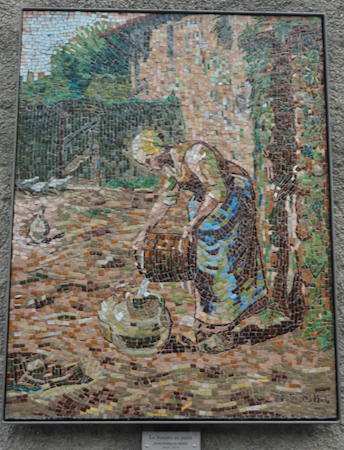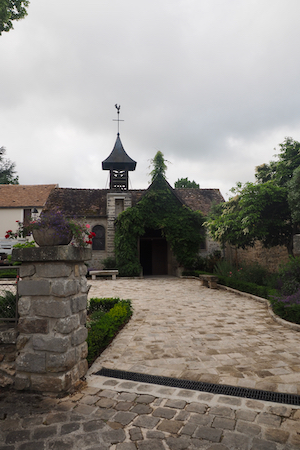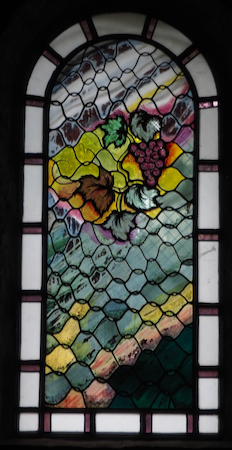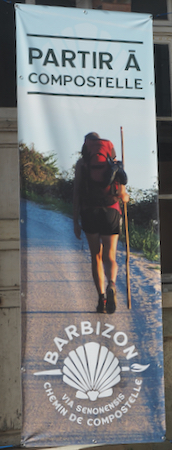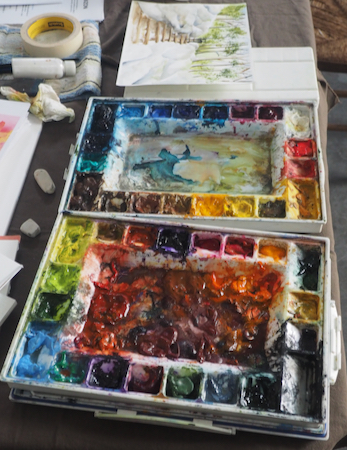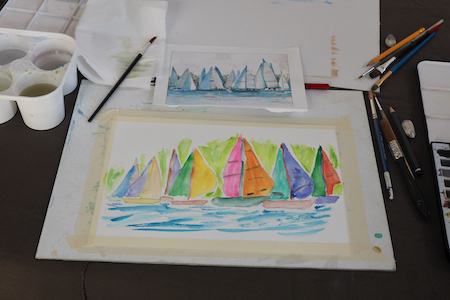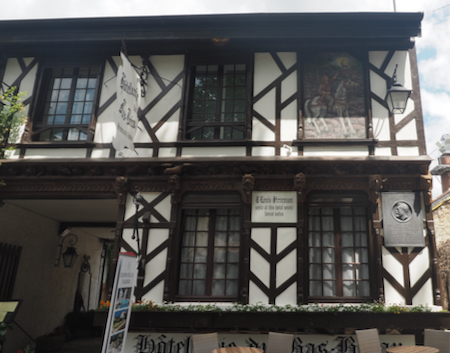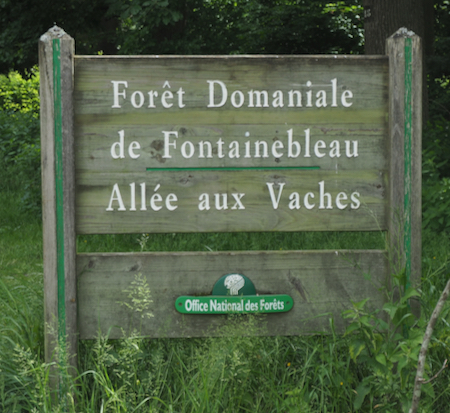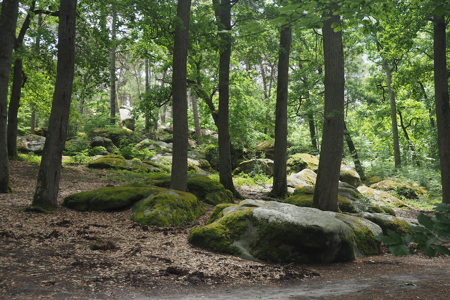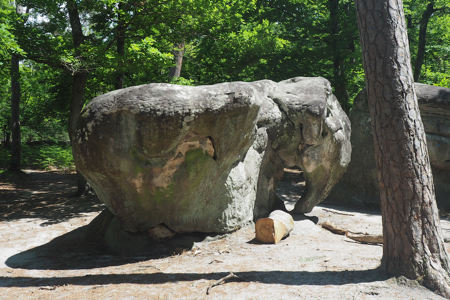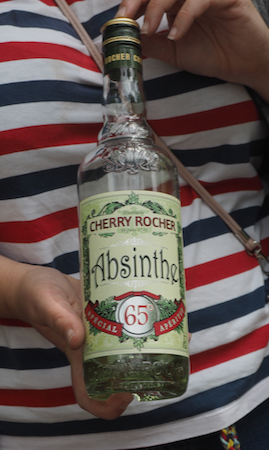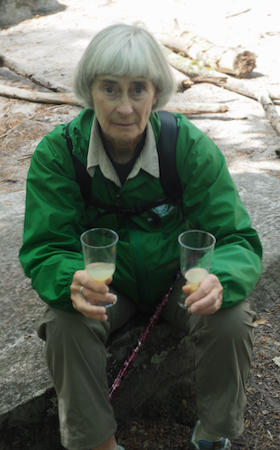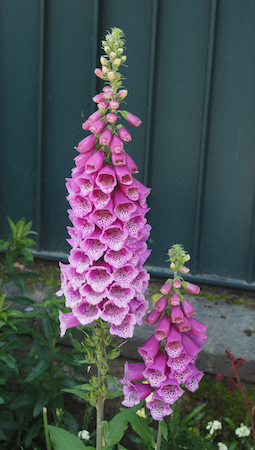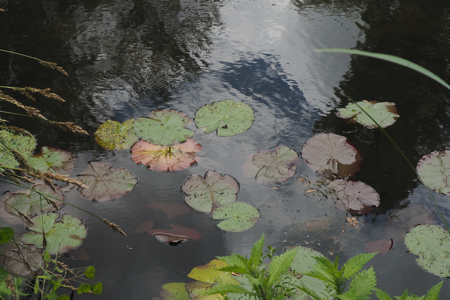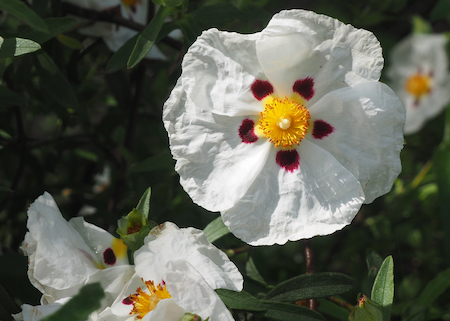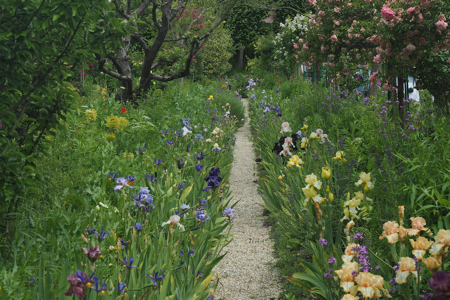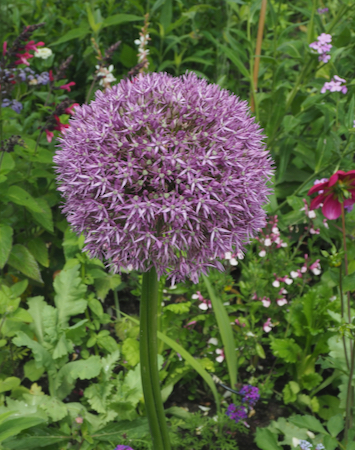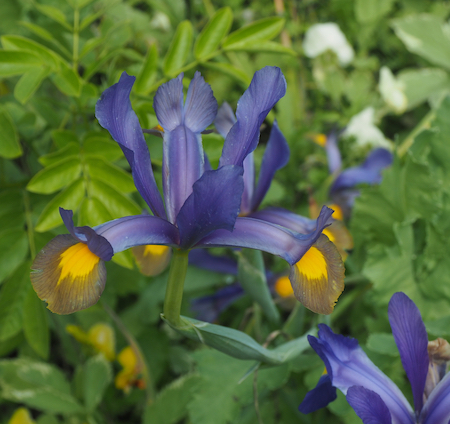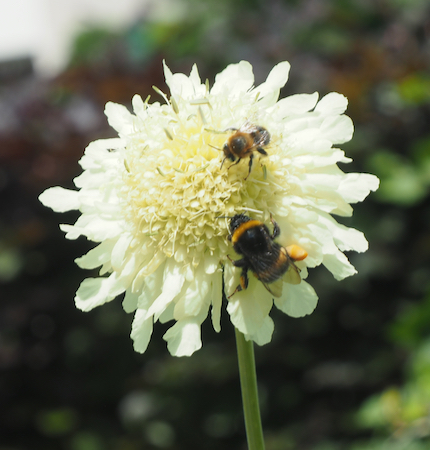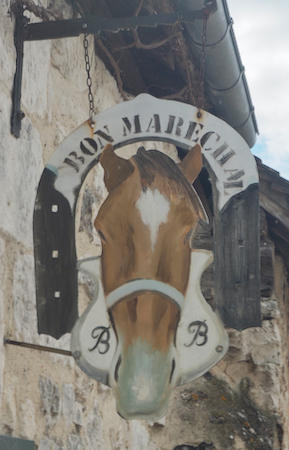Sun., 5/22/22 - Paris to Fontainebleau
At 7 AM we took the Insight shuttle to the airport to connect with the OAT shuttle out to Fountainebleau. The OAT representative was new and so the connection was anything but smooth but we finally accomplished it.
It was a nice ride to Fountainebleau. The grain fields around Paris changed to light woodlands as we neared Fontainebleau. There were many trailheads and bike paths.
At 4 PM our OAT Tour Director for the pre-trip, Stephanie, led the nine of us on a one-and-a-half-hour walk in our new neighborhood - down to the chateau and the city center. She talks non-stop but is interesting and informative as she tells us about this city.
OAT: French Impressions
Decorating the gates
Decorations for the electric vehicle charging station
Outside the hotel
Mon., 5/23/22 - Fontainebleau
It finally rained in France - for which they are very happy.
After our OAT briefing at 9 AM, the group walked down to the Chateau de Fontainebleau. The chateau was originally (1137) a defensive position between the Seine and the Loing rivers. Later it became a hunting mansion for those connected to the royals. But its opulence began with Frances I in 1528 and was built on and reconstructed by numerous kings: Henry II and IV, and Louis XII, XIV, XV, and XVI. The building was stripped of its furniture during the French Revolution and then refurbished by Napoleon I and used by Louis-Philippe and Napoleon III. Another special “guest” was Pope Pius VII, who was under house arrest here for two years.
Audio devices enhanced the experience of touring some of the chateau's 1,500-rooms.The first section was the Napoleon Museum and told the story of his life with exhibits of furniture, artwork, portraits, swords, metals, his ablution kit while on campaigns, his briefcase holding his Napoleonic laws, and baby Napoleon’s toys. This was followed by the Pope’s apartments and then the section of the Great Apartments. Every room had period furniture and a story of who made the furniture or who used it. The tapestries hanging ceiling to floor were impressive; the ballroom was over the top; Queen Marie de Medici’s bedroom would give most people nightmares; the Throne Room was almost plain; and the Chapel was the only place a visitor was allowed to sit! And Versailles will be twice as ornate?
Chateau de Fountainebleau (on a rainy day)
Gate of the Chateau
Interior scenes follow - all showing the excesses of the French Court - small wonder there was a Revolution!
Just a hallway
From the court orchestras
Even the ceilings!
The gardens - the rain kept us from touring these
A rainy walking tour of the town center followed the Chateau tour.
Our walk took us past a Liberty Road pylon. These mark the path of General Patton from Omaha Beach to liberate Paris. They are placed every 5 km.
The Church of Saint-Louis, dedicated to the patron saint of the Royal family was built in 1868 and was destroyed in 2009 by arson. The installation of the new stained glass windows was only finished in 2018.
Liberty Road pylon
Church of Saint-Louis
Organ - by now you should have noticed that I photograph just about every organ in every church.
Mairie de Fontainebleau - City Hall
Restaurant - dinner
Tues., 5/24/22 - Barbizon
Today was a fun day in the nearby town of Barbizon. It is now (as it was in the mid-1800s) an artist colony where Millet and Rousseau once lived and painted. Millet painted “L’Angelus” in the farm field outside the village. There are mosaic plaques in various places around the town that show a painting like “L’Angelus” at the site of the painting. Rousseau turned a barn into his second-floor studio and later the Chapel of St. Paul was built in the remainder of the barn. Millet’s studio is now a state museum.
Mosaic of L’Angelus by Jean-François Millet
Appropriate sign
Mosaic of The Gleaners by Millet
Mosaic of Woman with Water Jugs - Millet
Rousseau's Studio and the Chapel of St. Paul
Stained glass in the Chapel of St. Paul
Iconic Citroen car of 1950. The story of this car is that it was built with vouchers from a monthly magazine. Every month the subscriber could get one more part for the assembly of the car.
Another interesting building in this little, one-street village is the Cercle Laure Henry where each year 6,000 to 7,000 pilgrims stop on their way to Compostela.
Five of us went an art studio where a distinguished water color artist, Patricia (?), talked about water colors, demonstrated the technique, and then had us try our own skills. She let us choose a stencil (a penciled plan) of one of her drawings and set us loose with a bunch of brushes and a box of colors. Marge painted sail boats and Gale tried a sunflower. It was fun.
Box of watercolor paints
Hotel where Robert Louis Stevenson stayed while writing “Treasure Island.”
The whole group took a walk in the woods that had inspired so many impressionist painters. The trees are mostly oak, elm, and ash, although pines have more recently been planted to help hold the sandy soil. The ground cover is all ferns. This area was once under the ocean (3 million years ago) and has left interesting rocks of granite in odd shapes and arrangements. The swirling of currents created round patterns on many of the large boulders.
At the ”elephant rock” the group stopped to experience (more learning and discovery) absinthe, a 45 proof liquor served over a sugar cube with water added. It tasted of licorice. It was the favorite drink of Toulouse-Lautrec. It has hallucinogenic affects when it is made with wormwood.
Scattered boulders
”Elephant Rock”
Before we tried it!
Wed., 5/25/22 - Giverny
Today's trip was to Giverny to visit the Claude Monet's Gardens. Our drive took us from the woodlands around Fontainebleau, through farm land, through Paris holiday traffic, and into industrial areas, and across the Seine River.
Giverny is the small village where Claude Monet settled, painted, and died. We spent the morning visiting Monet’s house and gardens and the village. The weather was lovely and, in spite of the crowds, we thoroughly enjoyed walking in the gardens and around his man-made lily pond enjoying all the colorful flowers - almost every kind from iris to pansies and azaleas to marigolds. It was a wonderful day and interesting visit.
The Gardens
Foxglove
Lily pond
No flowers - Monet would be disappointed
Cistus flower
Iris walk
Allium Gladiator - an ornamental onion
Apple tree espaliered - grown on a low trellis like grape vines
Japanese Iris
Happy Bees
Nice sign
We arrived in Bayeux and checked into our hotel. Dinner tonight was chicken or fish done in “Normandy" style. It was good but the dessert was better - poached pear inside a cream puff.
| Return to Top | Return to Itinerary | Return to Trips page to view other trips | Return to Dreamcatcher Home Page |
